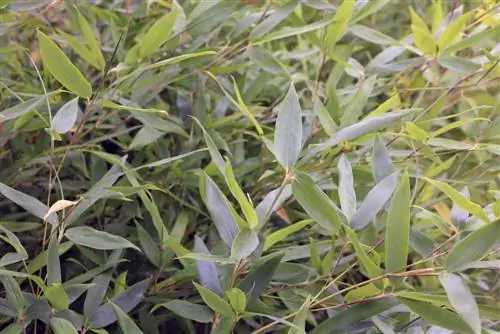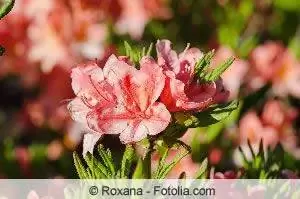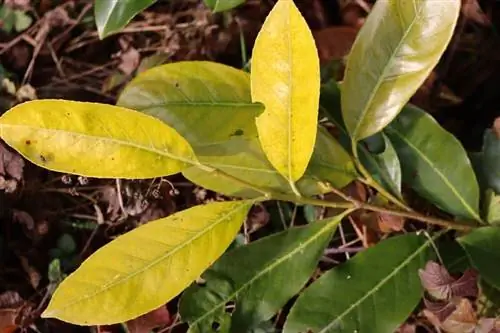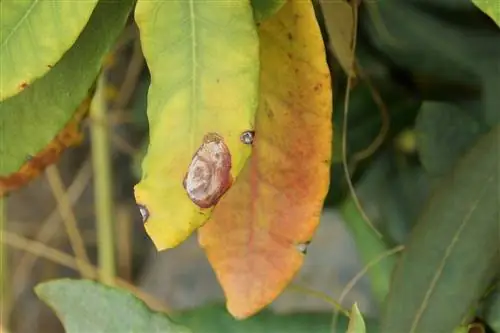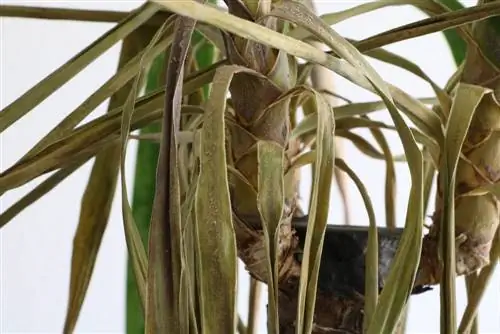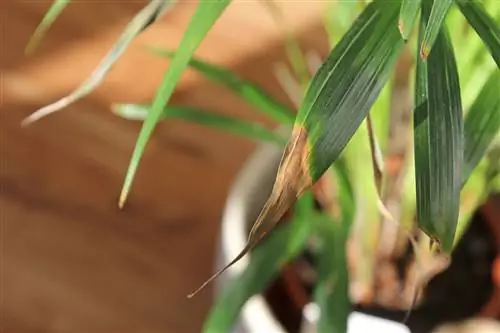- Author admin [email protected].
- Public 2023-12-17 03:39.
- Last modified 2025-01-24 12:45.
Yellow leaves and brown tips on bamboo are not a reason to panic; they can even have various completely natural causes. Otherwise there is a little work, correcting care errors, fighting pests and diseases, saving bamboo that freezes too much in winter, but you can do it and soon your bamboo will be completely green again:
Bamboo in the garden
There are a few reasons for a bamboo to develop yellow leaves and brown tips:
Various breeds
Perhaps your bamboo is developing yellow leaves because it was bred to do just that. There are some bamboo cultivars that are supposed to shine in yellow (usually gold in the sales description):
- Fargesia murielae 'Deep Forest', the key characteristic of the breeding variety is reddish shoot tips
- Fargesia murielae 'Green Arrows', forms light green young stalks, older stalks should turn yellow
- Fargesia denudata 'Lancaster 1', waterfall bamboo, which sprouts green bamboo stalks that are said to take on a unique, yellow shimmer in the sun
- Fargesia murielae 'Standing Stone' is also said to grow yellow stalks as it ages
- The newHibanobambusa tranquillans, a hybrid of Phyllostachys nigra 'Henonis' and 'Sasa', is available in green and variegated
- The popularHibanobambusa tranquillans 'Shiroshima' is one of the variegated forms with green-cream-colored leaves
- Pleioblastus viridistiatus is said to be “more yellow than any other bamboo”
- In thePleioblastus there are other bamboos with yellow, green, yellow-green and white-green leaves
The bamboos of the Fargesia variety always shed up to a third of their leaves during or until winter, and sometimes even half of the leaves in the first year. Before they do that, the tips of the leaves change color, then the leaves turn completely yellow, then they fall off. Completely naturally, every spring the Fargesia form new leaves, which then shine in fresh green.
Other species of bamboo also turn their leaves yellow in autumn, even though they are actually evergreen. It is also normal for evergreen plants to drop a few leaves during the cold season. The leaves of an evergreen plant do not live forever, but die after a different lifespan, and it is most effective for the plant to dispose of these leaves at the end of their lifespan when it needs them least, i.e. in winter.
Some bamboos have a lot of foliage, the better they are, the more, such bamboos can delight you with a similar autumnal golden yellow leaf color as a native deciduous tree. Of course, you will only be happy if you know that the golden yellow leaves are normal. In addition to information about the type of bamboo, a fresh green bamboo after the first autumn storm (with the leaves blown away on the ground) is a sure indication of natural leaf discoloration.
Correct temperature
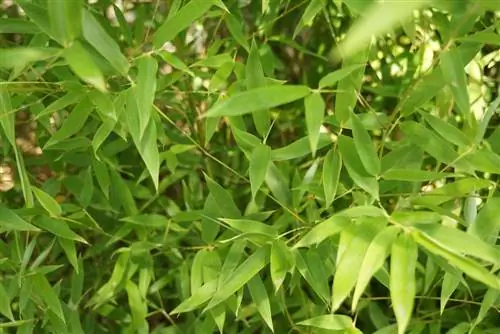
The world is big today, and the trading world is even bigger, so all kinds of bamboos are sold.
You have probably heard that many of the approximately 1,500 bamboo species like to send runners through the garden, which cannot always be kept well under control even with a rhizome barrier. You've probably done your research so you don't end up with one of those bamboos with leptomorphic rhizomes, or dug a very deep rhizome barrier into the garden soil.
What you may not have informed yourself about is the winter hardiness of bamboo - perhaps when you bought it, you assumed, like any sane person, that only plants that survive the winter are sold for planting in the German garden German garden survive.
So you thought like a human being, but not like a “homo oeconomicus” (the rational economic person invented by economists who is currently trying to take over the world). Homo oeconomicus is not intended to describe a purely egoistic person, but rather a rational person who clearly organizes all the important aspects before making a decision - but if "profit" is the most important aspect for the trader, this utility maximizer is only peripherally affected by whether his product also benefits the buyer, the main thing is to sell.
A short search for bamboo species currently available for German gardens brought up the following offers:
- Chusquea, in several species, but its homeland is in the tropics and subtropics
- Dendrocalamus gigantea, giant bamboo, comes from tropical regions of Asia, grows to a height of 40 m
- Dendrocalamus strictus, giant black bamboo, see above, only smaller
- Fargesia murielae 'Super Jumbo' is said to be hardy down to -25 °C, but is mostly grown in Denmark, where it is warmer than here
- AlsoF. murielae 'Dino', 'Hutu', 'Jutu' and 'Mammoth' usually come from Denmark and are not particularly frost hardy here
- Fargesia robusta Campbell, hedge bamboo, is only said to be hardy in warmer regions of Germany and can freeze completely in colder regions without good winter protection
- Hibanobambusa tranquillans 'Shiroshima', can withstand a maximum of -17 °C, it can get colder here
- Phyllostachys bambusoides, hardy between -14 to -20 °C, only for warm and mild areas
- Phyllostachys nigra, black bamboo, depending on the variety, hardy between -16/-20/-25 °C, v. a. Grows in warmer locations and is sufficiently hardy
- Phyllostachys pubescens, Moso bamboo, winter hardiness -16° to -21 °C, only well-rooted stocks in warmer regions are said to be well hardy
- Phyllostachys viridisglaucescens, is said to be really hardy only in warmer and milder regions of southern Germany
- Sasa are recommended from USDA hardiness zone 6 except for Sasa tsuboiana (USDA 5), in Germany it goes down to 5b
- Semiarundinaria fastuosa, also variety 'Viridis', USDA hardiness zone 6b to 10
If you have a bamboo like this in your garden, perhaps mass-produced in the laboratory that is a little less winter-hardy, the only solution is to put it in a pot, overwinter it in a cold house - and a few silent prayers to the plant gods.
Care errors
If your bamboo should actually only have green leaves and the discoloration is certainly not due to too much winter cold, poor care could be the cause:
- Wrong location? A Fargesia murielae needs e.g. B. at least 1.5 m² for yourself and some free space around you
- If it has been squeezed into a group planting, it can feel so crowded by neighbors that individual leaves are not cared for properly
- The bamboo or other plants next to it should then be moved
- Too much (burning midday) sun, too much shade? Depending on the type of bamboo, both can have fatal consequences; some bamboos are even bothered by too much sun on the roots
- Read the species' location requirements again in detail, plant protection or cut away or implement shading
- Too much moisture (wet feet=waterlogging), too little water? Most bamboos suffer from waterlogging, but need consistently slightly moist roots
- Perhaps you have placed the bamboo in a tight container as a rhizome barrier, which needs lots of holes and a tight wire wrap
- Otherwise, perhaps make the soil more permeable by mixing in sand or simply water more (in hot weather)
- Or in the cold, the evergreen bamboo needs some water on frost-free days, even in winter
- A single strong spray of liquid fertilizer that is too concentrated can cause discoloration after some time
- Too few nutrients gradually become noticeable
- In both cases, check and adjust fertilization (do not fertilize in winter)
- Some bamboo species feel more comfortable in fresh coastal regions in the long term than in the warm south of Germany
- In vineyard climates they grow very quickly, with many soft young stalks that are temporarily pulled to the ground and then perhaps turn yellow
- If a bamboo is not sheltered enough from the wind, a storm can snap the supply lines
- In both cases, plant shading or wind protection next to it or install it artificially
- A newly planted bamboo sometimes turns its leaves brown, seemingly for no reason
- This is called plant shock and can be remedied by generous watering
Pests and diseases
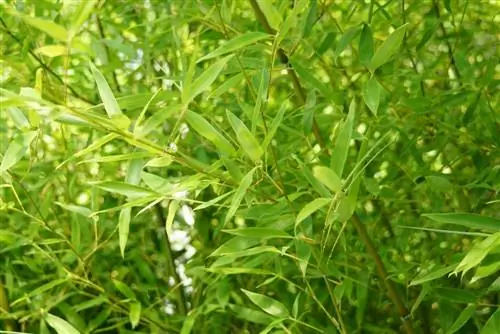
Pests and diseases are rarely observed on the robust bamboo plants, but of course (perhaps caused by care errors or freezing in winter) they can also be to blame for yellow leaves and/or brown tips:
- Bamboo, like any other plant, can be attacked by mealybugs or mealybugs
- These like to hide under the stalks of the bamboo plants
- The Fargesia are particularly frequently attacked
- From the beginning of March, aphids begin to suck on bamboo plants
- All of these can cause deformed, yellow, brown leaves
- Sooty mold fungi can migrate with the lice, resulting in more serious damage to which young bamboo plants can succumb
- If you notice sticky deposits on the leaves, the bamboo should be showered in horsetail broth or aphid killer
- Infected leaves should be collected
- Grain rust fungi can also attack bamboo and cause brown-orange spots on the leaves
- Especially bamboo that is too narrow and in too high humidity, so create space and air
- Once the discolored leaves have been thrown off, this haunting is usually over
- The leaves should be removed and disposed of
- Perhaps you also bought the Asian bamboo mite, which came from China with bamboo imports
- She particularly likes hard-leaved bamboo species, Phyllostachys for example
- In extremely dry weather, gall mites could also spread
- Bamboo plants in pots, dense bamboo hedges and bamboos that sit in a rhizome barrier that is too dry are particularly susceptible
- You can recognize mites by bright, narrow spots that spread on the top of the leaves
- Webs sit on the undersides of the leaves; Remove and burn infected leaves and stalks or treat with nettle manure, potash soap, acaricide
- Prevention: Shower the bamboo more often, water it generously and, if necessary, ensure higher humidity
- Whiteflies (Phyllostachys) and thrips appear in May and sometimes lay their eggs directly into the plant tissue
- Sucking causes silvery-light discoloration on the tops of the leaves
- Thrips and larvae sit on the undersides of the leaves and produce black feces spots
- Since neither tolerates moisture, you can get rid of them by showering the bamboo every day for a few days
- Prevention: Blue glue boards, yellow ones don't work here
- All of these little animals have fewer chances from the start if you maintain the natural insect police through natural garden management
- Ants, lacewings, ground beetles, ladybirds, predatory mites, hoverflies, spiders and wasps: each of these little animals ensures that certain other species do not take over
Yellow leaves and brown tips on bamboo in the pot
All of the situations and influences just described can also affect a bamboo in a pot, just a little faster or more than a bamboo in the garden. Keeping a plant “in prison” is only a “second choice” and it is more difficult to create optimal living conditions for the plant.
That's why things go wrong more quickly, the water drain in the bucket being blocked for a short time bathes the bamboo in waterlogging and can damage the roots. So every time you water, make sure that the drain is clear. A balanced nutrient supply is also more difficult to achieve: nutrient deficiencies (iron, magnesium, nitrogen), but also over-fertilization/salinization of the soil can cause chlorosis. So calculate fertilizer doses exactly or replace the soil if over-fertilization is likely.
Speaking of replacing soil: Potting soil is usually pre-fertilized, and even newly purchased bamboo plants usually only need to be fertilized after a year because they have been supplied with all the important nutrients by the breeder/dealer. If a bamboo grows well, it can become very dense at some point, then it needs to be thinned out by pruning, transplanted or divided. Otherwise, the yellow leaves or brown tips can be cut away at the latest in spring before new growth appears, then the entire stalk down to the ground. The more air the bamboo has to sprout again.
Conclusion
Yellow leaves and brown tips on a bamboo can have all sorts of causes, but they don't necessarily have to cause you to grow gray hair. Maybe it's just nature that turns the bamboo leaves yellow, otherwise you just have to correct the care mistakes orcontain the pests/diseases so that the next leaves grow green again.

